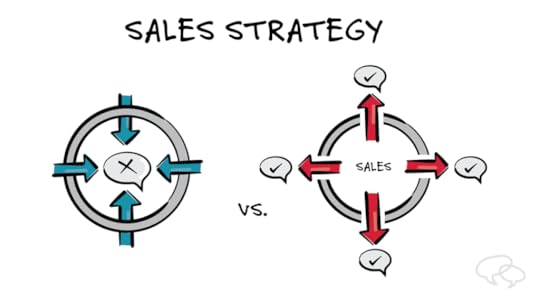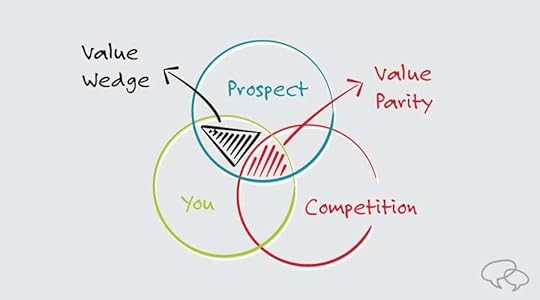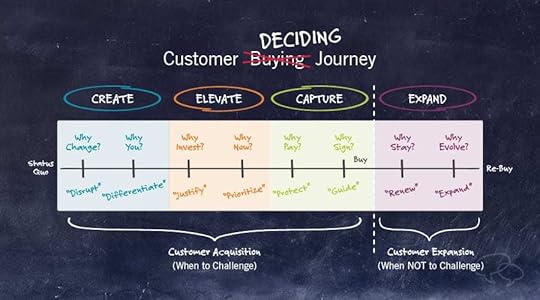Sales Strategy: What’s Most Effective? A Great Message!
The post Sales Strategy: What’s Most Effective? A Great Message! by Tim Riesterer appeared first on Corporate Visions.
[image error]

How do you create the best and most effective sales strategy? Most advice out there tells you that as long as you have a documented plan, a solid process, and a bullpen full of reps who know your solution inside and out, you’re ready.
Well, not quite.
The problem is, most sales
strategies are too internally focused. They succeed in documenting internal
procedures but lose sight of the messages and skills your reps need to communicate
value to your customers.
Consider the following insights:
Research performed by SiriusDecisions shows
that the number-one inhibitor to Sales achieving quota is an “inability
to communicate a value message.”In corresponding research in which SiriusDecisions
asked executive customers about the quality of interactions with
salespeople, only 10 percent said sales calls provide enough value
to warrant the time they spent on them.A Forrester Research study revealed that only
15 percent of sales calls add enough value, according to
executives surveyed.The Forrester study also showed that just seven
percent of surveyed executives say they would probably schedule a
follow-up.
In other words, if your sales
force can’t communicate value—why your solution is different, better, and worth
more—your sales strategy won’t help you get more sales.
So, what can you do?
In this article, you’ll learn 10
tips for building a sales strategy that actually works. Each one is backed by
research and has been rigorously tested and proven to be effective in B2B
selling situations.
But first, it’s important to
step back and clarify what it really means to create a successful sales
strategy.
What is a Sales Strategy?
A sales strategy is defined as a
documented plan for positioning and selling your product or service to
qualified buyers in a way that differentiates your solution from your
competitors.
Sales strategies are meant to provide clear objectives and guidance to your sales organization. They typically include key information like: growth goals, KPIs, buyer personas, sales processes, team structure, competitive analysis, product positioning, and specific selling methodologies.
Most of these guidelines are
helpful for communicating goals and keeping your sales reps on the same page.
Where most sales strategies fall short, however, is that they’re too focused on
the internal workings of your organization. The actual skills needed to have
winning conversations with customers—along with the messages reps need to be
successful—are merely an afterthought.
When you boil it down, the goal
of every sales strategy is to make sure your salespeople hit their quota,
right? And it’s the messaging element—what salespeople say, do, and write in
order to create perceived customer value—that wins or loses the deal.
To truly be effective, your organization’s
sales strategy needs to focus on customer conversations. These skillfully
delivered conversations are what creates a distinctive purchase experience, creates
value for your buyers, and separates your company from the competition.
With that in mind, here are 10
things to keep in mind when creating a sales strategy.
10 Keys to Developing a Successful Sales Strategy
1. Build a Powerful Value Proposition in Your Messaging
Most prospects either don’t
recognize or can’t articulate the root challenges they struggle with on a daily
basis. So, even if you sell a truly remarkable product, your buyers probably
won’t recognize the real value you offer to their organization. That’s why you
need to create your value with a powerful and persuasive message.
In fact, Forrester research found that 74 percent of executive
buyers will give their business to a company that illustrates a buying vision,
compared to vendors among a group of commodity suppliers.
This isn’t just about touting your product’s features, hoping that your buyer chooses you over your competition. That approach only puts you at value parity with similar solutions, and it forces a competitive bake-off.
[image error]

Instead of talking about what you do and why you think you can do it better, create a buying vision that defines a new set of challenges which align to your distinct strengths. This powerful value proposition will uncover previously unconsidered needs for your prospect, create contrast, and drive the urgency to change using stories and insights.
2. Create the Urgency to Change
Most companies unknowingly position
themselves for a competitive bake-off of features and benefits. They answer the
“why should I choose you?” question for their prospects. But in doing so, they
miss a critical first step.
The truth is that the majority
of buyers prefer to do nothing instead of change. In fact, 60 percent of
deals in the pipeline are lost to “no decision” rather than to competitors.
Staying the same is safe and comfortable, while change is associated with threat and risk. To break through Status Quo Bias and get prospects to leave their current situation, you need to tell a story that makes a compelling case for why they should change, and why they should change now.
Successful sales strategy requires you to understand your real competitor—the status quo. Help your prospects make the decision to change before you help them make the decision to choose you. Answering these questions are what creates your unique value, differentiates your solution, and sets the tone for your buyer’s entire Deciding Journey.
3. Tell a Compelling and Memorable Story
When salespeople prepare for
conversations with prospects, they usually focus on getting all the facts
straight about their offerings. But the most accurate information in the world
won’t resonate if you can’t connect with your customers in a memorable way.
Telling personal stories and using metaphors and analogies helps bring your message alive in a more compelling way than simply reciting facts and data. Storytelling paints a vivid picture for your buyers, illustrating the contrast between their current situation versus what’s possible, and connecting what you offer directly to their unique situation.
Once you start sharing stories
in your sales conversations, your customer relationships will become deeper and
more rewarding.
4. Speak to the Deciding Journey, Not Your Sales Process
A sales process is a set of
repeatable steps that a salesperson uses to lead a prospect to purchase.
Typically, the sales process involves several steps like prospecting,
qualifying, discovering needs, negotiating, and closing. This would be an ideal
checklist to follow if all your buyers were robots being taken through an
assembly line. But that’s just not the reality.
Marketing and selling today isn’t a predictable progression that you’ve decided is how your prospects and customers should buy. What you’re really up against today is a Customer Deciding Journey—a series of key questions your buyers are asking as they look to address specific business goals.
[image error]

Instead of being
“program-centric” with a one-size-fits-all sales strategy, you need to be
problem-centric, addressing the specific needs of your buyers as they arise
with situationally relevant messages, content, and the skills to deliver them.
5. Don’t Rely on Buyer Personas in Your Sales Strategy
Customer profiles and buyer personas sound good in theory. The idea is to collect common demographic attributes, attitudes, and behaviors of your target audience to help frame and target your messages. But when used as a superficial profiling approach, personas can lead your messaging astray.
Persona-based selling assumes
that the behaviors or actions of your target buyer are motivated by their
internal characteristics. In reality, buyers are motivated by outside
influences that challenge their status quo and convince them to change. These
outside influences might include rapid growth within the company, inefficient
or unsustainable processes, or broader changes that affect their industry as a
whole.
The real drivers behind
behaviors and behavior change are the challenges within your buyer’s situation,
not their professional disposition. So, instead of focusing your
sales strategy on a lot of inconsequential attributes, speak to your buyer’s
situation and why their current approach is putting their business at risk.
6. Avoid the “Commodity Trap” in Your Sales Strategy
Too often, salespeople base
their messaging on the needs that prospects tell them they have. Then, they
connect those identified needs to corresponding capabilities, in standard
“solution selling” fashion.
The problem with this approach?
You fall into the trap of commodity messaging along with your competitors, who
are likely constructing their value message in response to the same set of
inputs. As a result, you sound just like everyone else, leaving your prospects
indecisive and without any real urgency to change.
Instead, you need to introduce Unconsidered
Needs that extend beyond the identified, known needs and solve for those.
Introduce prospects to problems or missed opportunities they’ve
underappreciated or don’t even know about. Then, connect the Unconsidered Needs
you’ve identified to your differentiated strengths, which are uniquely suited
to resolve those risks.
Research conducted by Corporate Visions found that a provocative messaging approach that begins by introducing an Unconsidered Need enhances your persuasive impact by 10 percent.
7. Lead with Insights, Not Discovery Questions
Many salespeople try to be a “trusted
advisor”—asking their buyers discovery questions, diagnosing the customer’s
needs, and then presenting a solution that fits the criteria. But this approach
does you and your customer a disservice.
To be of real value to your
buyers, it’s not enough to say, “Tell me what you want; I’ll get it for you.”
Buyers want salespeople who will tell them what they should want. They want you
to sift through all the information that’s out there and deliver insight into
what they’re missing that will improve their performance.
This means more than just
finding data and statistics online. A fact without a story is just a data
point. To make it real for your buyer, wrap your insights in a story that
connects the dots for them and provides context within their world.
8. Align Sales and Marketing
Too often, sales and marketing are siloed departments, each with individual goals that appear compatible. Marketing creates sales messaging and tools and generates leads for the sales team. Sales teams use the messaging and tools to transform those leads into revenue. But a lack of alignment and gaps in your process can sabotage your efforts.
You might hear the following
complaint from both sides: “We’re doing our job, but they just don’t get it.”
The problem with these goals is that they foster an us-versus-them attitude and
miss the big picture. Sales is a design point for better marketing. If Sales is
the storyteller of your organization, then Marketing is the story builder.
Ultimately, these two teams share—and must be aligned to achieve—one purpose: to persuade buyers to choose you.
Get our State of the Conversation Report, The B2B Content Disconnect, to learn how to drive action and conversions with insights-driven content, before and after a sales rep enters the picture.
9. Tailor Your Sales Strategy for Customer Expansion
Most sales and marketing teams
spend the majority of their budgets and effort on customer acquisition and
demand generation. Meanwhile, the majority of your annual revenue likely comes
from your existing customers, through renewals and upsells.
Nearly half of the companies surveyed by Corporate Visions invest less than 10 percent of their marketing budgets in customer retention and expansion. Clearly, your customers are highly underrated yet powerful growth engines within your company. And you shouldn’t overlook the potential of this untapped revenue stream.
The challenge is, retention and
expansion require a distinct messaging and customer conversation approach.
Existing customers are in a different position than your prospects—one that
carries a unique buying psychology.
While customer acquisition is all about challenging the status quo to highlight the benefits of switching to your solution, customer retention and expansion requires you to reinforce your position as their status quo. In fact, research shows that using a provocative, challenging message when you’re trying to renew or expand business with your customers will increase the likelihood that they’ll shop around by at least 10-16 percent.
[image error]

Check out our e-book, To Challenge or Not to Challenge, to discover research-backed insights into when you should (and shouldn’t) challenge your buyer’s status quo.
10. Enable Ongoing Situational Training
Most training and learning
efforts are based on a collection of competencies, supported by a curriculum
and catalog that gets scheduled on calendar-based interest and availability.
But what does that have to do with helping the company’s business strategy,
responding to shifting market demands and intervening to fix emergent needs
when they arise?
To be as effective and efficient as you need to be today, your sales training has to rise to a new level of flexibility, customization, and situational relevance. Using a flexible, on-demand training model enables you to deploy it at a moment’s notice to solve problems as they occur, and tackle initiatives as they arise. Training your sales team for situational agility equips them with the messaging and skills they need relative to the customer conversations they’re having.
Take Your Sales Strategy Beyond “Best Practices”
Most of the so-called “best
practices” out there won’t help your sales team succeed. Instead of following a
fill-in-the-blanks template, create a strategy that communicates more value in
your sales conversations.
Only with Corporate Visions
will you learn tested and proven customer conversation approaches for enabling
buyers to choose you at every stage of the customer lifecycle. That’s why the best
global B2B sales organizations come to us when they want skills training and
messaging solutions that are backed by rigorous research and proven to improve
results.
Get our sales e-book, Winning the Four Value Conversations, to get more research-backed sales messaging and skills for building a sales strategy that actually works.
Thank you for reading this post from Corporate Visions - Differentiate Your Marketing Messages and Sales Conversations.
Timothy Riesterer's Blog
- Timothy Riesterer's profile
- 3 followers



